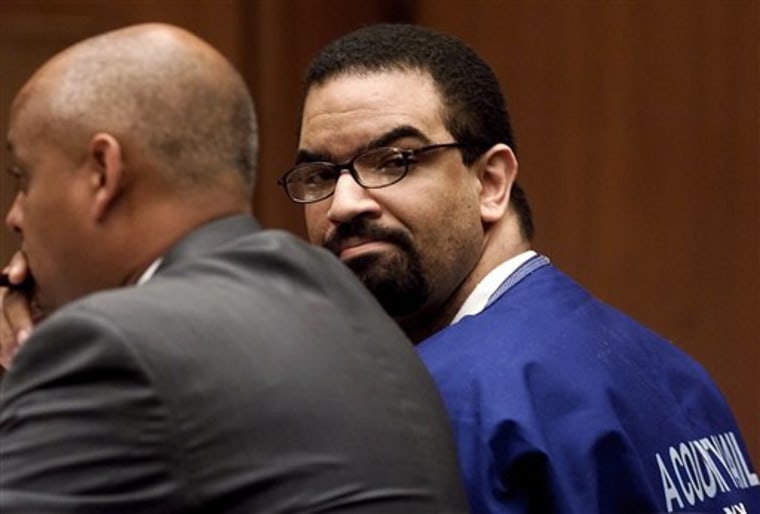Eleven years after an anti-gang cop was arrested for stealing six pounds of cocaine from an evidence room, city leaders believe the Los Angeles Police Department has dashed the image of corruption and abuse spawned by revelations of the theft investigation.
"The LAPD that through much of its history was maligned and criticized is now moving into the 21st century as a leader in creating positive change," Chief William Bratton declared after a federal judge this month freed his department from oversight by the U.S. Justice Department.
The assessment is a far cry from the reputation that allowed Hollywood to serve up such gritty LA cop tales as "Training Day" and "The Shield" in the aftermath of a decade that included the 1991 Rodney King Beating, the 1992 riot and finally an episode that became known as Rampart.
Bratton asserts further that the most important legacy of its reforms will be removal of barriers between the department and the diverse city, especially the black community. "We have the highest consensus between that community and this department in its history," he said.
Glowing view is not universal
The glowing view is not universal: Civil liberties watchdogs are willing to acknowledge significant progress by the LAPD, but insist there are still dramatic disparities in the way officers treat blacks and Latinos compared with other people.
The Rampart scandal erupted from the 1998 cocaine heist by Rafael Perez, which got the attention of the Justice Department and led to allegations of a wider pattern or practice of unconstitutional conduct due to failures to implement proper management practices.
Perez struck a plea bargain and painted a picture of a rogue force that framed, beat and shot people in Rampart, an eight-square-mile division west of downtown.
While the allegations produced little concern for gangster and drug dealer victims, the justice system was shaken.
Then-Chief Bernard Parks disbanded the elite anti-gang unit and ordered its plainclothes officers into uniforms.
Ultimately, nine officers were prosecuted, nearly two dozen were fired or suspended and scores of felony convictions were invalidated because of suspected police misconduct.
Millions paid to settle lawsuits
The city paid about $70 million to settle civil rights lawsuits, including $15 million to a man who was shot and paralyzed in a 1996 incident involving Perez and a partner. Framed by the officers, Javier Ovando had spent 2 1/2 years in prison before his conviction was overturned.
Five officers, including Perez, pleaded guilty during the Rampart probe
Perez was sentenced in 2001 to five years in state prison after pleading guilty to grand theft and cocaine possession, then was prosecuted in federal court for the Ovando case. He pleaded guilty and in 2002 received a two-year sentence. He later changed his name to Ray Lopez.
Four other officers were tried on Rampart charges. Three were convicted of conspiring to obstruct justice by framing two gang members, but a judge overturned the verdict and the case was dropped. They and the fourth officer, who was acquitted, sued and got a $20.5 million settlement from the city.
A Justice Department's threat to sue forced the city to adopt numerous reforms through a consent decree. The department moved to require anti-gang and narcotics officers to disclose their finances, develop a new computer system tracking officer conduct, and place video cameras in patrol cars to determine if officers engage in racial profiling. The cameras are in a test phase.
The agreement called for it all to be overseen by an independent monitor and a federal judge.
‘It was a wrong culture’
Eight years passed before U.S. District Judge Gary Allen Feess found that the department had become "the national and international policing standard" and replaced the decree with a transitional agreement in which progress will be reported to the city's civilian Police Commission.
"It was not just bad apples, it was a wrong culture, and it took us some time to change both," said City Council President Eric Garcetti, whose father was considered a political casualty of Rampart when he lost re-election as district attorney amid the fallout.
John Mack, one of the city's most prominent African-Americans who is now vice president of the Police Commission, contrasted his current view with the years he was "on the other side battling LAPD" in his long tenure as leader of the Los Angeles Urban League.
He recalled a "history of hostility, of tension and frankly of an oppressive attitude toward the African-American community and many communities of color."
"We clearly have made giant strides in truly transforming the institutional culture of LAPD, which is something that at one point in time a number of us certainly questioned would ever happen," Mack said.
Some say more progress needed
The American Civil Liberties Union of Southern California acknowledged "great progress" by the LAPD but opposed lifting the consent decree, said staff attorney Peter Bibring.
The organization contends that the goals of the decree remain incomplete, particularly in ending racial bias in policing.
"We think that to have the decree lifted when there are still problems in the management of gang units and unaddressed racial disparities sends the wrong message that these are acceptable problems for a department to have," Bibring said.
The Police Department has changed the name of what was its Consent Decree Bureau to the Risk Management Bureau, but Bratton insisted nothing else will change.
Gerald Chaleff, the administrator heading the bureau, said that under the consent decree, the department paid $12 million to the independent monitor for the first five-year period and then $156,000 a month during the final three years.
